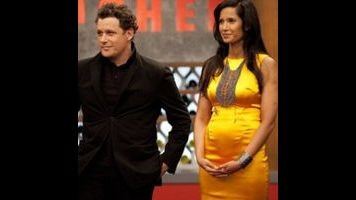Top Chef: "Gastro-nauts"

In terms of who of the final five might be sent home, Top Chef was edited like a whodunit flick where the villain is so obvious it couldn’t possible be him. When Kevin first appeared talking about all the bullets he dodged to get to the near-end, it seemed like a standard this-guy-is-going-home clip, like Anthony Edwards saying some long goodbyes before his fatal flight in Top Gun. But then, he appeared again in interview segment after interview segment, talking about his family, the rough times he’s had on the show, the fact that he doesn’t have a business like the other contestants, et al. Add to that the perpetual Stuart Smalley-esque self-affirmations, and there was no way that Kevin was out the door.
But first, the Quickfire. Dana Cowin, best known as editor of Food & Wine magazine and only slightly less well known as Ed’s friend on Facebook, shows up for—what else?—a pairing of food with wine. As Quickfire challenge ideas go, this has to be the least imaginative ever, but I liked it anyway, because food and wine pairings are an important part of the fine dining experience. I trust Dana’s probably right in that 90% of pairings are terribly misjudged, so that set a high enough bar for the chefs to make the challenge exciting. It was also nice to see all the high-end proteins that suddenly surfaced in the Top Chef kitchen, which just happened to have wagyu ribeyes and foie gras sitting around in case anyone wanted to use them.
All the self-affirmation in the world wasn’t going to braised Kevin’s pork belly any faster; we’ve learned plenty of times in the past that a proper braising requires more than an hour, but he either stupidly or hubristically chose to ignore the limitations of physics. He wound up substituting quail, knowing full well that it didn’t pair well at all with his wine, and was punished accordingly. Save for Kelly’s blue cheese foam, the other four fared well, with Angelo continuing his comeback by once again proving to be more skilled and sophisticated (and weirder) than the competition. His sautéed foie gras didn’t win him immunity or any Elimination advantage, but a trip to London seemed a fine compensation. (Is it me or are the chefs getting much bigger episode-to-episode prizes this year? Used to be you’d win a signed book; now you’re flown all over the world or winning $10,000 in cash.)
The Elimination challenge sounded much cooler and more technically difficult than it turned out to be. Dispatched to NASA headquarters in D.C., the chefs were asked to create a dish that could be freeze-dried and eaten by astronauts at the International Space Station. They were given certain parameters—cut in small pieces, don’t use a lot of sugar, spice it up if possible—but those parameters were all but abandoned once food got to plate. Top Chef historians will note the challenge’s familiarity with the semi-infamous Bertolli challenge from Season Three, where chefs, cooking for super-shill Rocco DiSpirito, had to make something that could be frozen, packaged, and reanimated at home. For as many problems as I had with the Season Three challenge as shill-ery, at least the show followed through on the conditions under which these dishes would be eaten. Here, Buzz Aldrin, Anthony Bourdain (woo-hoo!), and company talk a little about the technical problems of reproducing the food for space, but they get their dishes fresh out of the kitchen. What’s the challenge in that?
